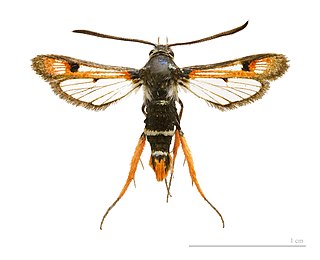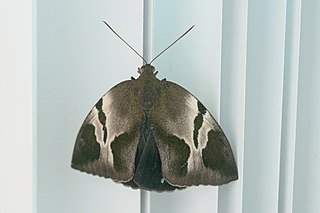Related Research Articles

Sesioidea is a superfamily containing clearwing moths (Sesiidae), castniid moths (Castniidae) and little bear moths (Brachodidae). There is evidence from head and thoracic morphology that the first two families, internally feeding in plants as caterpillars, are sisters, whilst some brachodids are known to feed on leaf surfaces. Sesioidea is closely related to Cossoidea, which contains the also internal-feeding Goat and Leopard moths, and recent taxonomic treatments consider the sessoid families as part of Cossoidea sensu lato.

Mimallonidae Burmeister (mimallonids), sometimes known as "sack-bearer" moths for the larval case-building behavior, are a family of Lepidoptera containing over 300 named species in 43 genera. These moths are found only in the New World, with most taxa occurring in the Neotropics. Adult moths are externally similar to those belonging to some of the other Macroheterocera families Bombycoidea and Drepanoidea, and thus have been variously treated as belonging to either one of these or other superfamilies.

Castniidae, or castniid moths, is a small family of moths with fewer than 200 species: The majority are Neotropical with some in Australia and a few in south-east Asia. These are medium-sized to very large moths, usually with drab, cryptically marked forewings and brightly coloured hindwings. They have clubbed antennae and are day flying, and are often mistaken for butterflies. Indeed, some previous classification systems placed this family within the butterflies or skippers. The Neotropical species are commonly known as giant butterfly-moths, the Australian and Asian species as sun moths. The larvae are internal feeders, often on roots of epiphytes or on monocotyledons.
Razowskiina is a genus of moths belonging to the family Tortricidae.

Phalonidia is a genus of moths belonging to the subfamily Tortricinae of the family Tortricidae.
Archipimima is a genus of moths belonging to the family Tortricidae.
Monoceratuncus is a genus of moths belonging to the family Tortricidae.
Rigidsociaria is a genus of moths belonging to the family Tortricidae.
Tambomachaya is a genus of moths belonging to the family Tortricidae.
Macasinia is a genus of moths belonging to the subfamily Tortricinae of the family Tortricidae.

The Atteriini are a tribe of tortrix moths.

The Euliini are a tribe of tortrix moths.
Lapaeumides is a genus of moths within the family Castniidae.

Xanthocastnia is a genus of moths within the family Castniidae containing only one species, Xanthocastnia evalthe, which is widespread in the Neotropical realm, ranging from southern Mexico to southern Brazil.
Lapaeumides actor is a moth in the Castniidae family. It is found in Brazil.

Lapaeumides ctesiphon is a moth in the Castniidae family. It is found in Brazil.

Marpesia zerynthia, the waiter daggerwing, is a species of butterfly in the family Nymphalidae. Primarily found in Mesoamerica, it can also be observed in regions slightly north and south of this area.
Archipimima labyrinthopa is a species of moth of the family Tortricidae. It is found in Brazil in the states of Santa Catarina and Paraná.
Sisurcana brasiliana is a species of moth of the family Tortricidae. It is found in Brazil.
Prometheus is a genus of moths within the family Castniidae. It was described by Jacob Hübner in 1824
References
- ↑ Lapaeumides at funet
- ↑ Lamas, G. (1995). A critical review of JY Miller’s checklist of the Neotropical Castniidae (Lepidoptera). Revista peruana de Entomología, 37, 73-87.
- ↑ de Moraes, S. S., & Duarte, M. (2014). Phylogeny of Neotropical Castniinae (Lepidoptera: Cossoidea: Castniidae): testing the hypothesis of the mimics as a monophyletic group and implications for the arrangement of the genera. Zoological Journal of the Linnean Society, 170(2), 362-399.
- ↑ González, J. M., Boone, J. H., Brilmyer, G. M., & Le, D. (2010). The giant butterfly-moths of the Field Museum of Natural History, Chicago, with notes on the Herman Strecker collection (Lepidoptera: Castniidae). SHILAP Revista de lepidopterología, 38(152), 385-409.